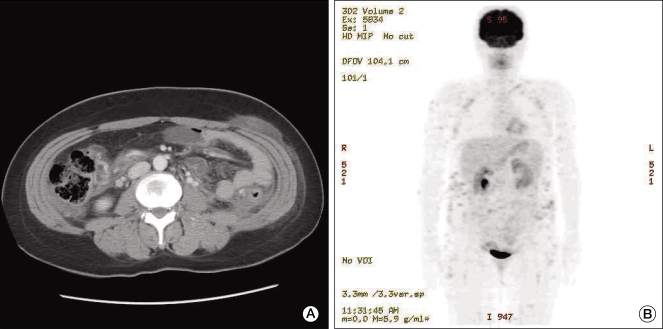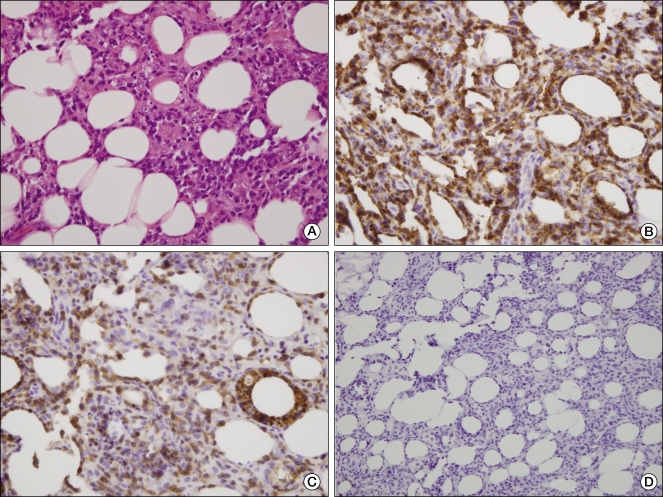Cancer Res Treat.
2011 Dec;43(4):255-259.
Cyclosporine in Relapsed Subcutaneous Panniculitis-like T-Cell Lymphoma after Autologous Hematopoietic Stem Cell Transplantation
- Affiliations
-
- 1Division of Hematology/Oncology, Department of Internal Medicine, Daegu Catholic University Hospital, Catholic University of Daegu School of Medicine, Daegu, Korea. sunghwa@cu.ac.kr
- 2Department of Pathology, Daegu Catholic University Hospital, Catholic University of Daegu School of Medicine, Daegu, Korea.
Abstract
- Subcutaneous panniculitis-like T-cell lymphoma (SPTCL) is a rare T-cell lymphoma characterized by involvement of the subcutaneous tissue of neoplastic T lymphocytes. SPTCL with hemophagocytic syndrome (HPS) is associated with an aggressive clinical course and treatment of SPTCL with HPS is not well established. Cyclophosphamide, doxorubicin, vincristine, prednisolone (CHOP) therapy is not successful in most patients suffering from SPTCL with HPS. The role of high dose chemotherapy followed by hematopoietic stem cell transplantation (HSCT) remains controversial. We report a case of relapsed SPTCL after CHOP chemotherapy and salvage chemotherapy followed by autologous HSCT, which had rapid improvement within weeks after cyclosporine and prednisolone. Immunosuppressive therapy may be an important and successful treatment option in SPTCL patients, even though they may have clinically aggressive disease.
Keyword
MeSH Terms
-
Cyclophosphamide
Cyclosporine
Doxorubicin
Hematopoietic Stem Cell Transplantation
Hematopoietic Stem Cells
Humans
Lymphohistiocytosis, Hemophagocytic
Lymphoma
Lymphoma, T-Cell
Panniculitis
Prednisolone
Stress, Psychological
Subcutaneous Tissue
T-Lymphocytes
Vincristine
Cyclophosphamide
Cyclosporine
Doxorubicin
Lymphoma, T-Cell
Panniculitis
Prednisolone
Vincristine
Figure
Reference
-
1. Gonzalez CL, Medeiros LJ, Braziel RM, Jaffe ES. T-cell lymphoma involving subcutaneous tissue: a clinicopathologic entity commonly associated with hemophagocytic syndrome. Am J Surg Pathol. 1991; 15:17–27. PMID: 1985499.2. Jaffe ES, Gaulard P, Ralfkiaer E, Cerroni L, Meijer CJ. Swerdlow SH, Campo E, Harris NL, Jaffe ES, Pileri SA, Stein H, editors. Subcutaneous panniculitis-like T-cell lymphoma. WHO classification of tumours of haematopoietic and lymphoid tissues. 2008. Lyon: IARC press;p. 294–295.3. Go RS, Wester SM. Immunophenotypic and molecular features, clinical outcomes, treatments, and prognostic factors associated with subcutaneous panniculitis-like T-cell lymphoma: a systematic analysis of 156 patients reported in the literature. Cancer. 2004; 101:1404–1413. PMID: 15368328.4. Willemze R, Jansen PM, Cerroni L, Berti E, Santucci M, Assaf C, et al. Subcutaneous panniculitis-like T-cell lymphoma: definition, classification, and prognostic factors: an EORTC Cutaneous Lymphoma Group Study of 83 cases. Blood. 2008; 111:838–845. PMID: 17934071.
Article5. Ghobrial IM, Weenig RH, Pittlekow MR, Qu G, Kurtin PJ, Ristow K, et al. Clinical outcome of patients with subcutaneous panniculitis-like T-cell lymphoma. Leuk Lymphoma. 2005; 46:703–708. PMID: 16019507.
Article6. Salhany KE, Macon WR, Choi JK, Elenitsas R, Lessin SR, Felgar RE, et al. Subcutaneous panniculitis-like T-cell lymphoma: clinicopathologic, immunophenotypic, and genotypic analysis of alpha/beta and gamma/delta subtypes. Am J Surg Pathol. 1998; 22:881–893. PMID: 9669350.7. Zhang H, Gupta R, Wang JC, Lipton JF, Huang YW. Subcutaneous panniculitis-like T-cell lymphoma in a patient with long-term remission with standard chemotherapy. J Natl Med Assoc. 2007; 99:1190–1192. PMID: 17987923.8. Reimer P, Rüdiger T, Müller J, Rose C, Wilhelm M, Weissinger F. Subcutaneous panniculitis-like T-cell lymphoma during pregnancy with successful autologous stem cell transplantation. Ann Hematol. 2003; 82:305–309. PMID: 12707721.
Article9. Mukai HY, Okoshi Y, Shimizu S, Katsura Y, Takei N, Hasegawa Y, et al. Successful treatment of a patient with subcutaneous panniculitis-like T-cell lymphoma with high-dose chemotherapy and total body irradiation. Eur J Haematol. 2003; 70:413–416. PMID: 12756026.
Article10. Nakahashi H, Tsukamoto N, Yamane A, Saitoh T, Uchiumi H, Handa H, et al. Autologous peripheral blood stem cell transplantation to treat CHOP-refractory aggressive subcutaneous panniculitis-like T cell lymphoma. Acta Haematol. 2009; 121:239–242. PMID: 19556752.
Article11. Advani R, Horwitz S, Zelenetz A, Horning SJ. Angioimmunoblastic T cell lymphoma: treatment experience with cyclosporine. Leuk Lymphoma. 2007; 48:521–525. PMID: 17454592.
Article
- Full Text Links
- Actions
-
Cited
- CITED
-
- Close
- Share
- Similar articles
-
- Autoimmune Diseases after Autologous Hematopoietic Stem Cell Transplantation in Patients with Non-Hodgkin's Lymphoma
- Cyclosporine A treatment for relapsed subcutaneous panniculitis-like T-cell lymphoma: a case with long-term follow-up
- Cyclosporine A as a Primary Treatment for Panniculitis-like T Cell Lymphoma: A Case with a Long-Term Remission
- A case of subcutaneous plasmacytomas of vessel puncture site in multiple myeloma after autologous stem cell transplantation
- Opening the era of in vivo xenotransplantation model for hematopoietic stem cell transplantation



